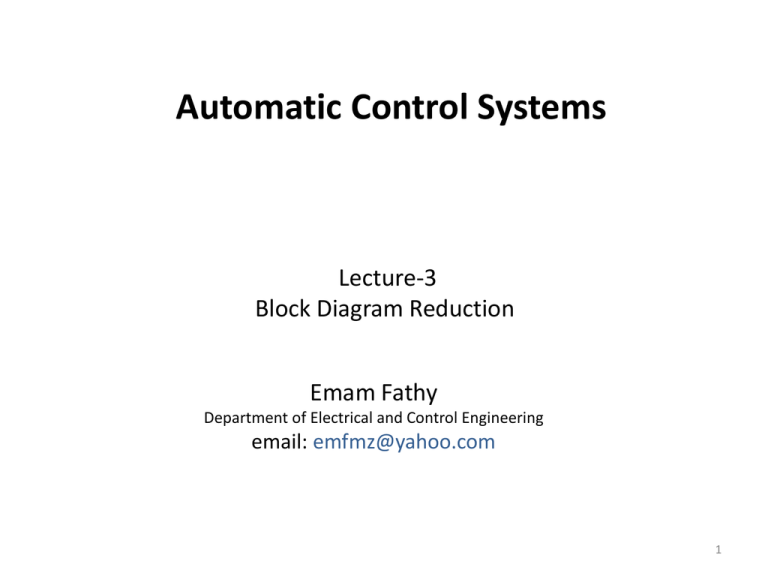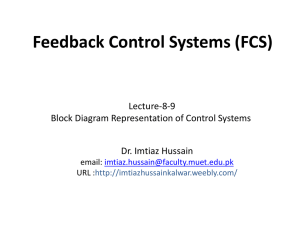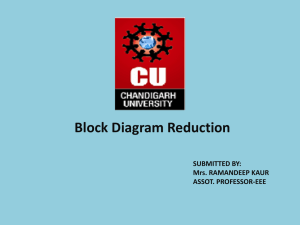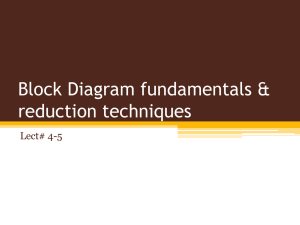Lec3 Block Diagram Reduction
advertisement

Automatic Control Systems Lecture-3 Block Diagram Reduction Emam Fathy Department of Electrical and Control Engineering email: emfmz@yahoo.com 1 Introduction • A Block Diagram is a shorthand pictorial representation of the cause-and-effect relationship of a system. • The interior of the rectangle represent the mathematical operation to be performed on the input to yield the output. • The arrows represent the direction of information or signal flow. x d dt y Introduction • The operations of addition and subtraction have a special representation. • The block becomes a small circle, called a summing point, with the appropriate plus or minus sign associated with the arrows entering the circle. • The output is the algebraic sum of the inputs. • Any number of inputs may enter a summing point. • Some books put a cross in the circle. Introduction • In order to have the same signal or variable be an input to more than one block or summing point, a takeoff point is used. • This permits the signal to proceed unaltered along several different paths to several destinations. Example-1 • Consider the following equations in which x1, x2, x3, are variables, and a1, a2 are general coefficients or mathematical operators. x3 a1 x1 a 2 x2 5 Canonical Form of A Feedback Control System Characteristic Equation • The control ratio is the closed loop transfer function of the system. C( s ) G( s ) R( s ) 1 G( s )H ( s ) • The denominator of closed loop transfer function determines the characteristic equation of the system. • Which is usually determined as: 1 G( s )H ( s ) 0 Example-4 G(s ) H (s ) B( s ) G( s )H ( s ) E( s ) 1. Open loop transfer function 2. Feed Forward Transfer function 3. closed loop transfer function 4. characteristic equation C( s ) G( s ) E( s ) C( s ) G( s ) R( s ) 1 G( s )H ( s ) 1 G( s )H ( s ) 0 In order to analyze the system, we want to represent multiple subsystems as a single transfer function. Reduction techniques 1. Combining blocks in cascade G2 G1 G1G2 2. Combining blocks in parallel (feed-forward) G1 G2 G1 G2 3. Eliminating a feedback loop G 𝑮 𝟏 ∓ 𝑮𝑯 H OR A B H 𝑨 𝑩 ∓ 𝑨𝑯 4. Moving a pickoff point behind a block G G 1 G 5. Moving a pickoff point ahead of a block G G G 6. Moving a summing point ahead of a block G G 1 G 7. Moving a summing point behind a block G G G Note A B B A Example 1 H2 _ R +_ + + G1 + H1 C G2 G3 Example H2 G1 _ R +_ + + + C G1 H1 G2 G3 Example H2 G1 _ R +_ + + C + G1G2 H1 G3 Example H2 G1 _ R +_ + C + G1G2 + H1 G3 Example H2 G1 _ R +_ + G1G2 1 G1G2 H1 C G3 Example H2 G1 _ R +_ + G1G2G3 1 G1G2 H1 C Example R +_ G1G2G3 1 G1G2 H1 G2G3 H 2 C Example R G1G2G3 1 G1G2 H1 G2G3 H 2 G1G2G3 C Example 2 Find the transfer function of the following block diagrams G4 R (s ) Y (s) G1 G2 G3 H2 H1 I G4 R(s) B G1 G2 A G3 H2 H1 G2 Solution: 1. Moving pickoff point A ahead of block 2. Eliminate loop I & simplify B G4 G2G3 G2 Y (s) G4 R(s) G1 A G2 G3 GG4 G B 2 Y (s) 3 H2 H 1G2 G4 G2G3 3. Moving pickoff point B behind block II R(s) G1 B G4 G2G3 H2 H 1G2 1 /(G4 G2G3 ) C Y (s) 4. Eliminate loop III R(s) G1 GG4 4GG 2G 3 3 2G 1 H 2 (GH4 2 G2G3 ) C C Y (s) G2 H1 G4 G2G3 R(s) G1 (G4 G2G3 ) 1 G1G 2 H1 H 2 (G4 G2G3 ) Y (s) G1 (G4 G2G3 ) Y ( s) T ( s) R( s) 1 G1G 2 H1 H 2 (G4 G2G3 ) G1 (G4 G2G3 ) Example 3 Find the transfer function of the following block diagrams R(s) G1 G2 H1 H2 H3 Y (s) Solution: 1. Eliminate loop I R(s) G1 A H1 G2 G2 1 GH2 H 2 2 I B Y (s) B Y (s) H3 G2 1 G2 H 2 2. Moving pickoff point A behind block R(s) G1 H1 G2 1 G2 H 2 A 1 G2 H 2 G2 H3 II 1 G2 H 2 H 3 H1 ( ) G2 Not a feedback loop 3. Eliminate loop II R(s) G1G2 1 G2 H 2 H3 Y (s) H1 (1 G2 H 2 ) G2 Y ( s) G1G2 T ( s) R( s) 1 G2 H 2 G1G2 H 3 G1H1 G1G2 H1H 2 Example 4 Find the transfer function of the following block diagrams H4 R(s) Y (s) G1 G2 G3 H3 H2 H1 G4 Solution: G4 1. Moving pickoff point A behind block I H4 R(s) Y (s) G1 G2 G3 H3 H2 H3 G4 H2 G4 H1 1 G4 1 G4 A G4 B 2. Eliminate loop I and Simplify R(s) G2G3G4 1 G3G4 H 4 G1 II Y (s) B H3 G4 H2 G4 III H1 II feedback G2G3G4 1 G3G4 H 4 G2G3 H 3 III Not feedback H 2 G4 H1 G4 3. Eliminate loop II & IIII R(s) G1G2G3G4 1 G3G4 H 4 G2G3 H 3 Y (s) H 2 G4 H1 G4 G1G2G3G4 Y ( s) T ( s) R( s) 1 G2G3 H 3 G3G4 H 4 G1G2G3 H 2 G1G2G3G4 H1 Example 5 Find the transfer function of the following block diagrams H2 R(s) G2 G1 H1 G4 A G3 Y (s) B Solution: 1. Moving pickoff point A behind block G3 I H2 R(s) G2 G1 A 1 G3 H1 H1 G4 G3 1 G3 B Y (s) 2. Eliminate loop I & Simplify H2 G3 G2 H1 R(s) G2G3 B H1 H2 G3 1 G3 G1 II G2G3 1 G2 H1 G2G3 H 2 H1 G3 G4 Y (s) B 3. Eliminate loop II R(s) G1G2G3 1 G2 H1 G2G3 H 2 G1G2 H1 Y (s) G4 G1G2G3 Y (s) T ( s) G4 R( s ) 1 G2 H1 G2G3 H 2 G1G2 H1 End of Lec 3 Example-5: Continue. Example-6: Reduce the Block Diagram. Example-6: Continue. Example-7: Reduce the Block Diagram. (from Nise: page-242) Example-7: Continue. Example-8: Reduce the system to a single transfer function. (from Nise:page-243). Example-9: Simplify the block diagram then obtain the closeloop transfer function C(S)/R(S). (from Ogata: Page-47) Example-10: Multiple Input System. Determine the output C due to inputs R and U using the Superposition Method. Example-11: Continue. Example-11: Continue. Example-19: Multiple-Input System. Determine the output C due to inputs R, U1 and U2 using the Superposition Method. Example-19: Continue. Example-19: Continue. Example-20: Multi-Input Multi-Output System. Determine C1 and C2 due to R1 and R2. Example-20: Continue. Example-20: Continue. When R1 = 0, When R2 = 0, Example-5: Reduce the Block Diagram to Canonical Form. Example-5: Continue. However in this example step-4 does not apply. However in this example step-6 does not apply. Example-6 • For the system represented by the following block diagram determine: 1. 2. 3. 4. 5. 6. 7. 8. Open loop transfer function Feed Forward Transfer function control ratio feedback ratio error ratio closed loop transfer function characteristic equation closed loop poles and zeros if K=10. Example-6 – First we will reduce the given block diagram to canonical form K s 1 Example-6 K s 1 K G s 1 K 1 GH 1 s s 1 Example-7 • For the system represented by the following block diagram determine: 1. 2. 3. 4. 5. 6. 7. 8. Open loop transfer function Feed Forward Transfer function control ratio feedback ratio error ratio closed loop transfer function characteristic equation closed loop poles and zeros if K=100. Block Diagram of Armature Controlled D.C Motor Ra La c Va ia eb T J La s Ra I a(s) K b(s) Va(s) Js c (s) K m aI a(s) Block Diagram of Armature Controlled D.C Motor La s Ra I a(s) K b(s) Ea(s) Block Diagram of Armature Controlled D.C Motor Js c (s) K m a I a(s) Block Diagram of Armature Controlled D.C Motor Block Diagram of liquid level system h1 h2 q1 R1 h2 q2 R2 dh1 C1 q q1 dt dh2 C2 q1 q2 dt Block Diagram of liquid level system L h1 h2 q1 R1 H1 ( s ) H 2 ( s ) Q1 ( s ) R1 L h2 q2 R2 H 2 (s) Q2 ( s ) R2 dh1 C1 q q1 dt L C1sH1( s ) Q( s ) Q1( s ) dh2 C2 q1 q2 dt L C2 sH 2 ( s ) Q1( s ) Q2 ( s ) Block Diagram of liquid level system H1 ( s ) H 2 ( s ) Q1 ( s ) R1 H 2 (s) Q2 ( s ) R2 C1sH1( s ) Q( s ) Q1( s ) C2 sH 2 ( s ) Q1( s ) Q2 ( s ) Block Diagram of liquid level system


